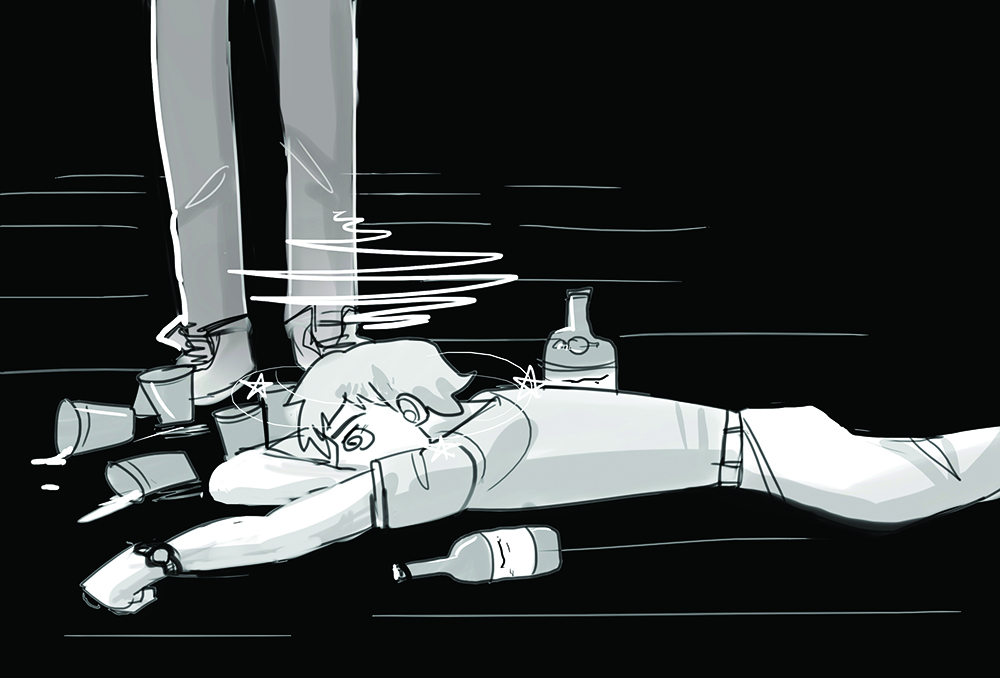Matt Dionne | Sports and Health Editor
Featured illustration: “One tequila, two tequila, three tequila, floor” was hopefully not your motto for this year’s frosh week. | Jasmine Wiradharma
The college party is a staple of North American culture. With an influx of new students on campus during frosh, many people will be experiencing their first college party in the next couple of weeks.
There might be some questionable romantic trysts, some new lifelong friendships forged and there might even be an appearance from Toronto’s finest, but there will most definitely be alcohol.
While a couple of drinks at a party can be seen as a way to release stress or provide the necessary courage to talk to the pretty girl or boy on the other side of the room, overindulging can have serious consequences.
So, let’s do the math.
The average Canadian male between the ages of 18 and 19 weighs about 144 lbs. One drink constitutes 1.25 ounces of hard liquor, 355 ml of beer, or five ounces of table wine. If they have eight drinks over a period of four hours, their blood alcohol content, or BAC, will be 0.15 per cent. For context, the maximum legal BAC a fully licensed driver can have is 0.08. The effects of 0.15 per cent BAC include a lack of physical control, blurred vision, major loss of balance, impaired judgment and perception and reduction of euphoria. Additionally, dysphoria, anxiety and restlessness begin to appear, according to Be Responsible About Drinking, or BRAD.
The average Canadian female between the ages of 18 and 19 weighs about 124 lbs, which means if they have eight drinks over a period of four hours, their BAC will be 0.24 per cent. The effects of this include the severe impairment of mental, physical and sensory functions, an increased risk of asphyxiation from choking on vomit and seriously injuring themselves in falls or other accidents, according to BRAD.
At 0.3 per cent BAC, an individual may not know where they are, and may pass out suddenly and be difficult to awaken.
At 0.35 per cent BAC, an individual may slip into a coma, as this level of intoxication is comparable to surgical anesthetic.
Unfortunately, most parties don’t have breathalyzers on hand to help determine whether your friend is experiencing alcohol poisoning.
Some of the signs that a person’s BAC may have reached toxic levels include mental confusion, stupor, coma, that the person cannot be roused, vomiting, seizures, slow breathing — fewer than eight breaths per minute — irregular breathing — 10 seconds or more between breaths — and hypothermia. This is characterised by low body temperature, bluish skin colour and paleness, according to College Drinking.
If you suspect someone is experiencing alcohol poisoning, you should call emergency services immediately. Don’t wait for all the signs to be present, and don’t try to guess the level of intoxication.
While waiting for emergency medical technicians to arrive, gently turn the person onto their side so they are lying on their stomach with their head resting on their arm. Don’t leave them alone at any time, and be prepared to administer CPR.
Remember there is a chance that a person who has passed out may not regain consciousness, and there is a serious risk of death.
Even if the victim lives, an alcohol overdose can lead to permanent brain damage. Rapid binge drinking — which often happens on a bet or a dare — is especially dangerous, as the victim can consume a fatal amount before falling unconscious.
This doesn’t mean you should quit drinking and check in to AA immediately. If you are going to drink, be sure to do so in moderation, try to avoid drinking on an empty stomach and stay hydrated.


